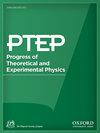Search for dark energy with neutron interferometry
IF 8.3
4区 物理与天体物理
Q1 Physics and Astronomy
引用次数: 0
Abstract
We use previously obtained experimental results by neutron interferometry to effectively constrain the parameter space of several prominent dark energy models. This investigation encompasses the environment-dependent dilaton field, a compelling contender for dark energy that emerges naturally within the strong coupling limit of string theory, alongside symmetron and chameleon fields. Our study presents substantial improvements over previous constraints of the dilaton and symmetron fields, improving parameter constraints by several orders of magnitude. However, the analysis does not yield any new constraints on the chameleon field. Furthermore, we establish constraints for the projected neutron split interferometer, which has recently concluded a decisive proof-of-principle demonstration. Our symmetron simulations reveal that depending on the parameter values there are multiple static solutions with increasing number of nodes and increasing energy inside a cylindrical vacuum chamber. This agrees with results obtained earlier in the literature for infinitely parallel plates. Interestingly, while these multiple solutions can correspond to domain walls forming inside the vacuum chamber, we also find solutions that do not reach their vacuum expectation value inside the vacuum chamber, but display multiple nodes nonetheless.用中子干涉测量法寻找暗能量
我们利用之前通过中子干涉测量获得的实验结果,有效地约束了几个著名暗能量模型的参数空间。这项研究包括依赖环境的稀拉顿场,它是弦理论强耦合极限下自然出现的暗能量的有力竞争者,同时还包括对称子场和变色龙场。我们的研究大大改进了以往对稀释子场和对称子场的约束,将参数约束提高了几个数量级。然而,分析并没有对变色龙场产生任何新的约束。此外,我们还为投影中子分裂干涉仪建立了约束条件,该干涉仪最近完成了一次决定性的原理验证。我们的对称电子模拟显示,根据参数值的不同,在一个圆柱形真空室内存在多个节点数量和能量不断增加的静态解。这与之前文献中对无限平行板的研究结果一致。有趣的是,虽然这些多重解可能对应于在真空室内形成的畴壁,但我们也发现了在真空室内没有达到真空期望值,但仍显示出多重节点的解。
本文章由计算机程序翻译,如有差异,请以英文原文为准。
求助全文
约1分钟内获得全文
求助全文
来源期刊

Progress of Theoretical and Experimental Physics
PHYSICS, MULTIDISCIPLINARY-PHYSICS, PARTICLES & FIELDS
CiteScore
12.00
自引率
5.70%
发文量
148
审稿时长
17 weeks
期刊介绍:
Progress of Theoretical and Experimental Physics (PTEP) is an international journal that publishes articles on theoretical and experimental physics. PTEP is a fully open access, online-only journal published by the Physical Society of Japan.
PTEP is the successor to Progress of Theoretical Physics (PTP), which terminated in December 2012 and merged into PTEP in January 2013.
PTP was founded in 1946 by Hideki Yukawa, the first Japanese Nobel Laureate. PTEP, the successor journal to PTP, has a broader scope than that of PTP covering both theoretical and experimental physics.
PTEP mainly covers areas including particles and fields, nuclear physics, astrophysics and cosmology, beam physics and instrumentation, and general and mathematical physics.
 求助内容:
求助内容: 应助结果提醒方式:
应助结果提醒方式:


